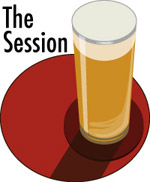You connect the dots.
The conversation
John Harris, whose Ecliptic Brewing should be serving beer soon, was talking about the first months at Deschutes Brewery in 1988, where he wrote the initial recipes and brewed for four years. Batch after batch of beer tasted sour, and he dumped each one. It turned out that there was a design/construction flaw. Fixing that solved the problem.
“These days we could probably have saved the (sour) beer and made money on it.”
He laughed, but he was serious.
The story
Joe Stange’s DRAFT magazine story I mentioned a while back later came on line, leading to discussion here and there, particularly interesting here, about how many breweries is too many breweries. Beyond the matter of variety discussed first time around, there is the one about quality.
“What the industry is afraid of is low quality, and that will taint the quality of craft beer overall,” says Jeff Schrag, owner of Mother’s Brewing, a regional microbrewery that opened in 2011 in Springfield, Mo. “But I don’t know,” he adds, looking thoughtful. “There’s a lot of beer now that’s tainting the image of craft beer.”
Some links
– Brian Yaeger riffs on this at The New School in a post titled, “95% a-hole free?” . . . as opposed to the good old “asshole free” days.
It’s not like this is new. Consider what Ken Grossman had to say in 1981 in Zymurgy magazine (summarized by Maureen Ogle in Ambitious Brew: The Story of American Beer): “More often than not, he complained, homebrewers tried to go commercial ‘on a shoestring, and with such low technology and understanding of producing a high quality beer’ that they produced foul swill.”
That might come across as a little chippy. Would it be better to be specific, to name names? Last week Charlie Bamforth, the Anheuser-Busch endowed Professor of Brewing Science a the University of California at Davis, was in St. Louis. He spoke a few minutes at a Master Brewers Association of the Americas (MBAA) gathering. I’m told that “back in the day” almost everybody at these meetings worked at Anheuser-Busch and wore a tie. A lot more beards these days. Plenty of young faces, including many people who work at the ABI pilot brewery and students in a brewing class at Washington University. Bamforth was as entertaining as always, shifting quickly from one topic to another. At one point, and I’m not exactly sure why, he said, and I must paraphrase, one thing he can’t abide by is one brewer talking bad about another. So that’s something you learn in beer school.
– Brandon Hernandez pokes a hornet’s nest with “Truth in beer reporting and other novel concepts.”
Yes, the fact that Hernandez derives income from Stone Brewing Co. (as a communications specialist) muddies the water, but lots of interesting insights in the comments. And you’ll want to read what another panelist had to say, and then Alan McLeod’s take.
– Boak & Bailey, starting from an entirely different place (a post by Adrian Tierney-Jones), ask a question: End of the Kid Gloves Era? Maybe this is inside baseball (or cricket), just writers talking to writers, but consider this: “Perhaps it is time for beer writers to accept that conflict with ‘the industry’ is necessary and desirable.”
That way the brewers don’t have to be the a-holes.
 James Davidson at Beer Bar Band has posted the roundup for
James Davidson at Beer Bar Band has posted the roundup for